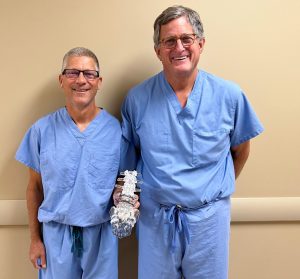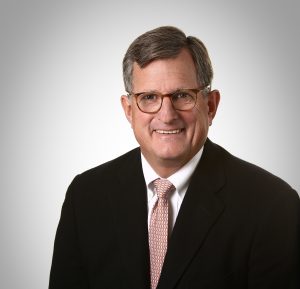OHOW Surgeon, Dr. Stephen Robbins, Completes First Implantation of Innovative TOPS™ System
 Orthopaedic Hospital of Wisconsin is proud to be home to the first-ever implantation of the TOPS™ System in Wisconsin. The successful surgery was completed by OHOW physician, Dr. Stephen Robbins and the remarkable OHOW surgical team.
Orthopaedic Hospital of Wisconsin is proud to be home to the first-ever implantation of the TOPS™ System in Wisconsin. The successful surgery was completed by OHOW physician, Dr. Stephen Robbins and the remarkable OHOW surgical team.
Dr. Robbins and his extraordinary team are setting new standards of patient care by embracing the TOPS™ System – an innovative, clinically proven superior alternative to spinal fusion for treating conditions such as lumbar spinal stenosis and degenerative spondylolisthesis.
Dr. Robbins and his team have completed the pioneering work necessary to bring cutting-edge treatments to his patients, changing many lives and shaping the future of spinal care. As OHOW strives to be a center for excellence, we allow for innovation and the best-in-class treatments that meet the needs of our patients.
Learn more about Dr. Robbins’ work and the groundbreaking TOPS ™ System in the blog post below.
Dr. Robbins Background of Excellence
 Dr. Robbins began his surgical training at The Orthopedic Department of The Medical College of Wisconsin. During his residency, his interest in spine-related issues first began to grow. To pursue this interest further, Robbins completed a one-year fellowship at the University of Toronto Sunnybrook Medical Center, where he worked with various instrumentation systems for many spinal conditions.
Dr. Robbins began his surgical training at The Orthopedic Department of The Medical College of Wisconsin. During his residency, his interest in spine-related issues first began to grow. To pursue this interest further, Robbins completed a one-year fellowship at the University of Toronto Sunnybrook Medical Center, where he worked with various instrumentation systems for many spinal conditions.
“At that time, there were a lot of new devices being created but clinical studies were necessary to document their efficacy,” Dr. Robbins said.
Following his fellowship in 1988, Dr. Robbins began his practice in Milwaukee using some of the newest instrumentation systems available, bringing the most innovative procedures to his patients. He continued his involvement with spinal instrumentation companies as both a clinical investigator and product developer.
Around 2000, Dr. Robbins’ passion for motion preservation of the spine began. Prior to that, most options for spinal surgery included either a laminectomy, discectomy or spinal fusions. The latter over time produced significant patient apprehension because of the loss of mobility and the development of adjacent level changes possibly requiring more surgery.
“There was a lot of work being done in orthopedics for innovating on joint replacements,” Dr. Robbins said. “So, why not the spine?”
He then became involved with total disc replacements for the lumbar and cervical spine. It was around 2010 that Dr. Robbins become an investigator for the Total Posterior Spine System (TOPS ™) device, an innovative alternative to a typical spinal fusion procedure.
Bringing the TOPS Device to Market
The initial investigation for the TOPS ™ device began as a study with randomization between single level fusion or the TOPS ™ device for patients with a degenerative spondylolisthesis. The device was highly effective, with similar results to a typical spinal fusion with several added benefits. The most noticeable positive outcome of the TOPS ™ device is the preservation of motion,
While the initial trials with the device were very successful and showed positive outcomes, the expense of bringing a new device to the market was too great to proceed. The study was closed, but Dr. Robbins continued to follow his patients. A few years passed, and Premia Spine, the development company for the TOPS device, presented Robbins’ patients and others to the FDA. Based on their long-term outcomes, a new multicenter clinical study began.
Over the five-year trial, the patient outcomes of the TOPS ™ device were superior to a typical fusion in all measures for appropriate patients, those with spondylolisthesis and spinal stenosis.
In June of 2023, Dr. Robins and his team completed the very-first non-trial implementation of the TOPS ™ device in Wisconsin at the Orthopaedic Hospital of Wisconsin. It was only the second implementation of the device outside the trial setting in the United States.
“OHOW, an outstanding institution, recognized that this device has a significant benefit not only to this individual but also to the community by offering a device with a superior outcome,” Dr. Robbins said.
The patient, a 72-year-old female, presented with degenerative spondylolisthesis and spinal stenosis, accompanied by neurogenic claudication at L4-L5. Having heard about the transformative potential of the TOPS™ System almost a year ago, she courageously decided to wait until the completion of the trial, determined to avoid the traditional fusion approach.
Her decision was rewarded post-procedure when she experienced such profound relief that it moved her to tears. She expressed deep gratitude for this groundbreaking technology and found immediate relief from her pain when she woke up from surgery.
Innovation of the TOPS System
The TOPS™ system functionally replaces the bone and soft tissues removed during the spinal decompression. The TOPS™ device helps maintain spine stability and preserves motion at that segment in all directions. The mechanical device contains two titanium plates connected by a polycarbonate urethane boot. The TOPS™ device is implanted in a procedure called ‘posterior arthroplasty.’
Despite the effectiveness, fusion procedures limit motion and change the mechanics of the lumbar spine. The TOPS™ device provides a spine surgery alternative to fusion and restores controlled movement in the damaged segment. The device typically doesn’t increase stress at other spinal levels, which leads to adjacent-level degeneration. The TOPS™ motion preservation device can restore near-normal motion, improving patients’ short- and long-term functional outcomes.
Additionally, Dr. Robbins states that the recovery process from implementing a TOPS device versus a typical fusion is much shorter.
“When you perform a fusion, it takes approximately 6 months for the bone to fuse, which limits one’s activities.” Dr. Robbins said. “With the TOPS device, there is immediate stability, consequently, you can start moving faster and return to normal activities within a few weeks to a month.”
Further, Dr. Robbins notes that he has not needed to perform any revisions nor encountered broken hardware in TOPS device cases, proving the longevity of the device over the 15 years of implementation. Additionally, the outcome has been superior to fusion for leg pain relief often associated with spinal stenosis.
“It’s very uncommon for a new spine surgery device to get superior ratings. With a new device, what you’re first hoping for is that it’s not inferior and that it has at least a similar outcome as the historical predicate,” Dr. Robbins said. “This device received a superior rating from the FDA and will be a “game changer” for the treatment of spondylolisthesis.
Countless patients with conditions such as lumbar spinal stenosis and spondylolisthesis stand to benefit from this innovative technology. At Orthopaedic Hospital of Wisconsin, we are grateful to Dr. Robbins and his team for their commitment to exploring cutting-edge treatments that will change lives and continue to shape the future of spinal care.
If you or a loved one suffers from spinal degeneration and requires a consultation for a spine injury, Orthopaedic Hospital of Wisconsin is here to help. Our team of experienced orthopedic surgeons will find the best treatment options to fit your needs.
Contact us today to start your road to recovery and return to health.







